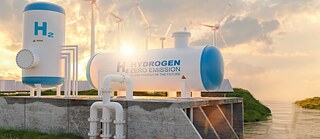Morocco’s drive to build a competitive green hydrogen industry is set to accelerate after the country completed the installation of its first prototype system for producing the fuel.
The “Power-to-X µPilot” system was designed and established as part of the “Power-to-X” project at the Green Energy Centre in the central city of Ben Guerir, in cooperation with the Mohammed VI Polytechnic University. It is supervised by researcher Nahila Nabil, Director of Green Hydrogen Systems at the Institute for Research in Solar Energy and Renewable Energies.Nabil confirmed that the pioneering technology is a promising way of reducing greenhouse gas emissions and helping Morocco’s transition away from fossil fuels. The prototype is a platform for “testing, capacity building, training and innovation, across all stages of the green hydrogen value chain, from supplying electricity from renewable sources to generating hydrogen, as well as chemically converting it for various applications,” she said.
The Moroccan media has been abuzz since the institute announced the project’s completion last month, good news for a country that has long relied on foreign imports of fossil fuels for its energy needs.
At the heart of the process of producing this future fuel is the use of clean, renewable energy from the sun, wind and water, in all of which Morocco has enormous potential.
Green hydrogen is produced by separating water from oxygen via electrolysis. This makes it a clean energy source, providing that the power used in the electrolysis is clean. The process produces zero harmful emissions, as is the case during combustion, meaning it is an environmentally sustainable fuel.
In addition to its portability, green hydrogen is also easy to store, allowing it to be used later for various purposes. It is also versatile. It can be burned to produce electricity or converted into synthetic gas and used for domestic, commercial, industrial or transportation purposes. It can also be mixed with natural gas in specific proportions.
“The unit will also include a green ammonia production system and a methanol collection system to produce green fuel, and we expect to test the different applications of green fuel,” Nabil said.
“In the short term, this prototype will play a major role in training researchers, doctoral and master’s students, and technical staff, who will be put in charge of operating the first facilities for green hydrogen production and its applications in Morocco, as well as training other researchers in the medium and long term.”
The project’s partners also hope to expand its role at the regional level by providing training opportunities. In September, the Institute partnered with several local and regional bodies to hold the first edition of its training course, the Middle East and Africa Clean Technology Academy.
“It’s a promising project in terms of its scientific and research value, given Morocco’s new direction towards energy transition, especially as the kingdom was one of the first Arab countries to launch a national road map for green hydrogen until 2050.”
Khaled Al-Salmi, an expert in sustainable energy management at Morocco’s Regional Center for Renewable Energy and Energy Efficiency (RCREEE)
The Power-to-X µPilot project drew praise from Khaled Al-Salmi, an expert in sustainable energy management at Morocco’s Regional Center for Renewable Energy and Energy Efficiency (RCREEE).
“It’s a promising project in terms of its scientific and research value, given Morocco’s new direction towards energy transition, especially as the kingdom was one of the first Arab countries to launch a national road map for green hydrogen until 2050,” he said.
“The project was designed to take into account both technical effectiveness and economic feasibility, compared to the other prototypes in the region, of which there are very few,” he said, referring to the Dubai Electricity and Water Authority’s green hydrogen project.
“The project will contribute positively to creating an integrated system that will facilitate various kinds of technical and scientific research, with an economic dimension, and strengthen Morocco’s position as a major economic competitor in the international market for green hydrogen,” he said.
Morocco has six other major projects to produce green hydrogen and its derivatives, following efforts since 2018 to explore the opportunities offered by the green hydrogen sector.
This led to the establishment of the national committee charged with creating a road map for the production of hydrogen and its derivatives with renewable energy. In March 2021, the country also created the Green Hydrogen Cluster, a national group dedicated to applied research, innovation and industry in this field.
"There is a need to strengthen regional cooperation in scientific research, [...]."
Khaled Al-Salmi, an expert in sustainable energy management at Morocco’s Regional Center for Renewable Energy and Energy Efficiency (RCREEE)
Al-Salmi listed several challenges associated with developing the green hydrogen system. They include “factors that raise the cost of producing one kilogramme of it, which can only be tackled with more scientific and technical research to find appropriate, practical solutions, and of course with a methodology that takes into account the economic feasibility of the proposed solutions,” he said.
Al-Salmi added that prototypes such as the Moroccan project are important contributors to creating a suitable climate for research and development to help overcome challenges, whether economic or environmental.
“There is a need to strengthen regional cooperation in scientific research, which is an essential pillar to implementing the national road map for green hydrogen,” he said.
*This report was published as part of the author's participation in the Science Journalism Workshop and through the "Journalism and Science in the Middle East and North Africa" project, which is a project of the Goethe-Institut funded by the German Foreign Ministry. It was first published on scidev.net.
April 2023
